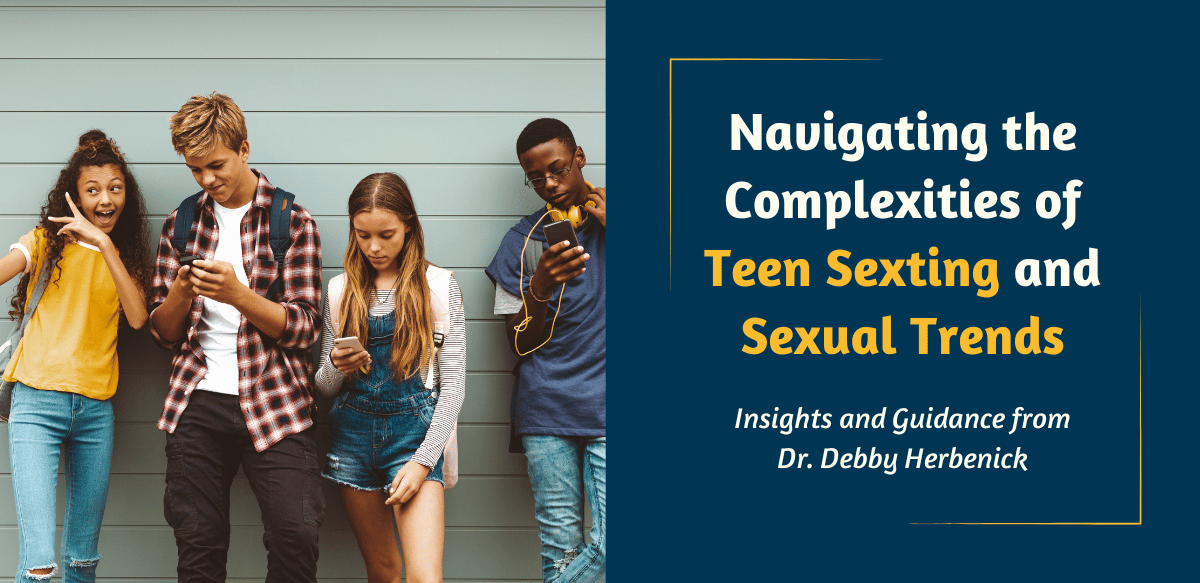
Insights and Guidance from Dr. Debby Herbenick
A surprising one-third of young people between the ages of 11 and 21 have received a “sext.” Sexting (sending or receiving texts, photos, or videos containing sexually explicit content) has become a common behavior, especially among older teens. In a recent article in the Wall Street Journal, psychologist Debby Herbenick brings to our attention that sexting is a topic of enormous concern, especially among parents of teens. Parents know that once a message is sent, they lose control over it, potentially leading to the content spreading widely across the of the internet.
Texts containing sexual content may seem harmless to young people because they often do not consider these serious potential consequences:

- It’s Illegal: Sending sexts that contain images of a minor is considered pornography and could lead to an arrest.
- Unintended Uses: Young people may send sexts to current romantic partners without considering what might happen with that content once the relationship is ended. Might the other person share it in ways that the sender didn’t intend?
- Harassment: Content in sexts can be used to scare, threaten, and, in other ways, bully the sender.
- The Long Term: Teens are now beginning to learn that inappropriate social media content might be viewed by friends, family, and even potential employers. Younger people are typically unaware of this possibility.
Unfortunately, teens often won’t talk about sexting with their parents. They may fear that the parent will take away their cell phone entirely, become angry, or not be patient enough to discuss the matter constructively with them. Herbenick emphasizes the importance for parents to engage in conversation with their children about texting. This dialogue should be characterized by open communication rather than a one-sided lecture, as it is crucial for parents to understand the specifics of how the text was received and by whom. Guidance should be provided on appropriate responses (or non-responses) to such messages. Patience and compassion are the keys to these discussions.
Parents Must Face the Reality of Sexting
In the Safer Society webinar interview Sexual Behaviors in the Current Era, Dr. Herbenick discusses findings from her research highlighting the common perception among parents that their teenagers are viewed as innocent, leading them to believe their children would not engage in sexting. As a result, the topic of sexting is addressed indirectly (“Be careful when you text”) or too simplistically (“Don’t do it”). However, sexting behavior is quite complex, and even if a teen doesn’t initiate it, sexting requests may come to them from friends and even strangers asking them to post pictures, videos, or texts with them about their sex lives.
Herbenick and Recent Trends in Sexual Behavior
Dr. Herbenick also discusses emerging trends uncovered in her research, such as an increase in the reported frequency of rough sex among teens. These behaviors include a sexual activity increasingly seen in freely available porn sites: choking. Furthermore, Herbenick explains that some teens experience “vanilla shaming,” a term that conveys the societal pressure some youths face to engage in adventurous sexual activities to avoid being perceived as mundane or unexciting in intimate relationships.
Another trend Herbenick discusses in the free hour-long interview (available below) is the mainstreaming of what is called “consensual non-consent” (also referred to as role-playing rape or simply “CNC”) among teens. Couples in the “kink” community who engage in these activities prioritize clear communication before and after such role-playing in order to safeguard the activity. However, as this kind of behavior spreads outside those communities, these norms and values around the activities are not going mainstream, which could result in negative sexual experiences for those involved.
Conclusion
The prevalence of sexting among young people, with a surprising one-third of individuals aged 11 to 21 having received a “sext,” underscores the urgent need for awareness and proactive parental engagement. The risks associated with sexting, from legal implications to potential harassment and long-term consequences, highlight the importance of educating both teens and parents on responsible digital behavior.
As parents navigate the complexities of addressing sexting and sexual behaviors with their children, fostering open dialogue, patience, and compassion are essential. By acknowledging the realities of sexting and staying informed about emerging trends in teen sexual behavior, parents can play a crucial role in guiding their children toward healthy and respectful interactions both online and offline.
We invite you to watch this free, hour-long webinar with Debby Herbenick on Sexual Behaviors in the Current Era.
